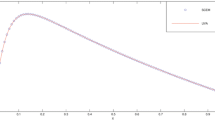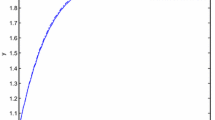Abstract
Based on the precise integration method (PIM), a coupling technique of the high order multiplication perturbation method (HOMPM) and the reduction method is proposed to solve variable coefficient singularly perturbed two-point boundary value problems (TPBVPs) with one boundary layer. First, the inhomogeneous ordinary differential equations (ODEs) are transformed into the homogeneous ODEs by variable coefficient dimensional expansion. Then, the whole interval is divided evenly, and the transfer matrix in each sub-interval is worked out through the HOMPM. Finally, a group of algebraic equations are given based on the relationship between the neighboring sub-intervals, which are solved by the reduction method. Numerical results show that the present method is highly efficient.
Similar content being viewed by others
References
Chawla, M. M. A fourth-order tridiagonal finite difference method for general non-linear two-point boundary value problems with mixed boundary conditions. Journal of the Institute of Mathematics and Its Application, 21, 83–93 (1978)
Kadalbajoo, M. K. and Patidar, K. C. A survey of numerical techniques for solving singularly perturbed ordinary differential equations. Applied Mathematics and Computation, 130, 457–510 (2002)
Vigo-Aguiar, J. and Natesan, S. An efficient numerical method for singular perturbation problems. Journal of Computational and Applied Mathematics, 192, 132–141 (2006)
Andargie, A. and Reddy, Y. N. Fitted fourth-order tridiagonal finite difference method for singular perturbation problems. Applied Mathematics and Computation, 192, 90–100 (2007)
Chakravarthy, P. P., Phaneendra, K., and Reddy, Y. N. A seventh-order numerical method for singular perturbation problems. Applied Mathematics and Computation, 186, 860–871 (2007)
Herceg, D. and Herceg, D. On a fourth-order finite-difference method for singularly perturbed boundary value problems. Applied Mathematics and Computation, 203, 828–837 (2008)
Evrenosoglu, M. and Somali, S. Least squares methods for solving singularly perturbed two-point boundary value problems using Bézier control points. Applied Mathematics Letters, 21, 1029–1032 (2008)
Habib, H. M. and El-Zahar, E. R. Variable step size initial value algorithm for singular perturbation problems using locally exact integration. Applied Mathematics and Computation, 200, 330–340 (2008)
Lubuma, J. M. S. and Patidar, K. C. Toward the implementation of the singular function method for singular perturbation problems. Applied Mathematics and Computation, 209, 68–74 (2009)
Kumar, M. and Mittal, P. A. Methods for solving singular perturbation problems arising in science and engineering. Mathematical and Computer Modelling, 54, 556–575 (2011)
Goh, J., Majid, A. A., and Ismail, A. I. M. A quartic B-spline for second-order singular boundary value problems. Computers and Mathematics with Applications, 64, 115–120 (2012)
Tan, S. J. and Zhong, W. X. Numerical solution of differential Riccati equation with variable coefficients via symplectic conservative perturbation method (in Chinese). Journal of Dalian University of Technology, 46(S1), S7–S13 (2006)
Fu, M. H., Lan, L. H., Lu, K. L., and Zhang, W. Z. The high order multiplication perturbation method for time-varying dynamic system (in Chinese). Scientia Sinica-Physica, Mechanica and Astronomica, 42, 185–191 (2012)
Zhong, W. X. and Williams, F. W. A precise time step integration method. Proceedings of the Institute of Mechanical Engineers Part C, Journal of Mechanical Engineering Science, 208(C6), 427–430 (1994)
Gu, Y. X., Chen, B. S., Zhang, H. W., and Guan, Z. Q. Precise time integration method with dimensional expanding for structural dynamic equations. AIAA Journal, 39(12), 2394–2399 (2001)
Fu, M. H., Cheung, M. C., and Sheshenin, S. V. Precise integration method for solving singular perturbation problems. Applied Mathematics and Mechanics (English Edition), 31(11), 1463–1472 (2010) DOI 10.1007/s10483-010-1376-x
Nayfeh, A. H. Perturbation Methods, Wiley, New York (1979)
Author information
Authors and Affiliations
Additional information
Project supported by the National Natural Science Foundation of China (Key Program)(Nos. 11132004 and 51078145)
Rights and permissions
About this article
Cite this article
Zhang, Wz., Huang, Py. Coupling of high order multiplication perturbation method and reduction method for variable coefficient singular perturbation problems. Appl. Math. Mech.-Engl. Ed. 35, 97–104 (2014). https://doi.org/10.1007/s10483-014-1775-x
Received:
Revised:
Published:
Issue Date:
DOI: https://doi.org/10.1007/s10483-014-1775-x
Key words
- high order multiplication perturbation method (HOMPM)
- reduction method
- variable coefficient singular perturbation problem
- two-point boundary value problem




